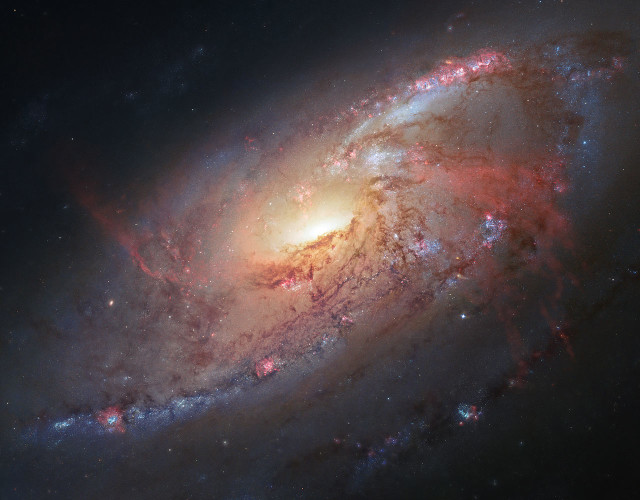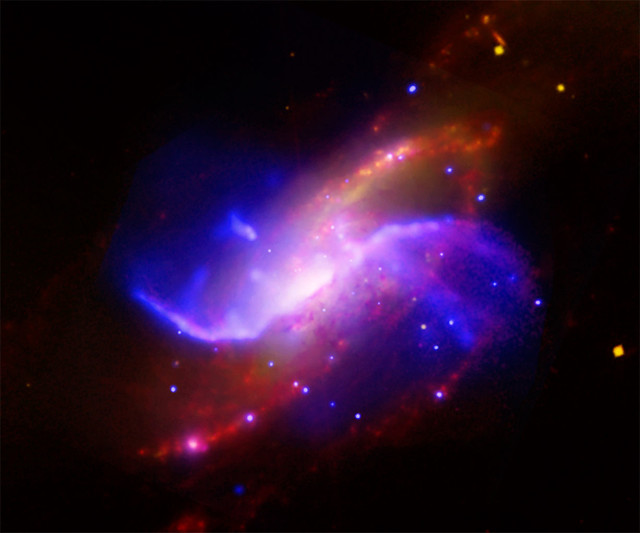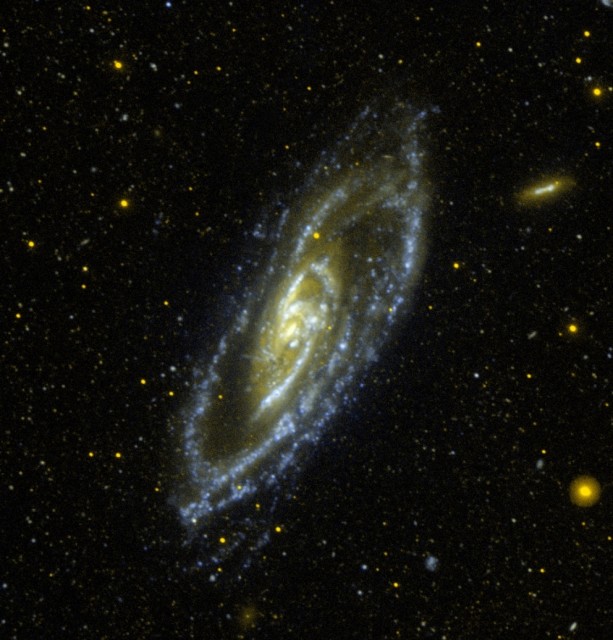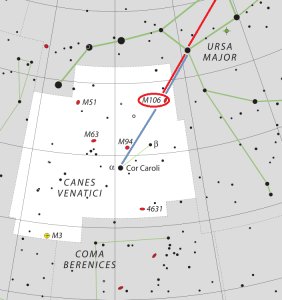Messier 106 (M106) is a spiral galaxy located in the northern constellation Canes Venatici. The galaxy lies at a distance of 22 to 25 million light years from Earth. It has the designation NGC 4258 in the New General Catalogue.
M106 has a distinct S-shape, formed by its spiral arms and bright nucleus. The galaxy is known for its two extra spiral arms, formed by the gas that the central black hole is blasting out of the galactic plane. The anomalous spiral arms are not aligned with the galaxy’s plane but rather intersect with it. They glow in optical, X-ray, and radio light. They have been shaped by enormous shockwaves caused by the jets emanating from the supermassive black hole at the centre of the galaxy. The two additional spiral arms appear as wisps of gas in visible light images, but are much more prominent in radio waves or X-rays. Unlike the galaxy’s two regular arms, which contain stars, the anomalous arms are made of hot gas.

At its heart, as in most spiral galaxies, is a supermassive black hole, but this one is particularly active. Unlike the black hole at the centre of the Milky Way, which pulls in wisps of gas only occasionally, Messier 106’s black hole is actively gobbling up material. As the gas spirals towards the black hole, it heats up and emits powerful radiation. Part of the emission from the centre of Messier 106 is produced by a process that is somewhat similar to that in a laser – although here the process produces bright microwave radiation [1]. As well as this microwave emission from Messier 106’s heart, the galaxy has another startling feature – instead of two spiral arms, it appears to have four. Although the second pair of arms can be seen in visible light images as ghostly wisps of gas, as in this image, they are even more prominent in observations made outside of the visible spectrum, such as those using X-ray or radio waves. Unlike the normal arms, these two extra arms are made up of hot gas rather than stars, and their origin remained unexplained until recently. Astronomers think that these, like the microwave emission from the galactic centre, are caused by the black hole at Messier 106’s heart, and so are a totally different phenomenon from the galaxy’s normal, star-filled arms. The extra arms appear to be an indirect result of jets of material produced by the intense churning of matter around the black hole. As these jets travel through the galactic matter they disrupt and heat up the surrounding gas, which in turn excites the denser gas in the galactic plane and causes it to glow brightly. This denser gas closer to the centre of the galaxy is tightly-bound, and so the arms appear to be straight. However, the looser disc gas further out is blown above or below the disc in the opposite direction from the jet, so that the gas curves out of the disc — producing the arching red arms seen here. Image: NASA, ESA, the Hubble Heritage Team (STScI/AURA), and R. Gendler (for the Hubble Heritage Team). Acknowledgment: J. GaBany
Messier 106 is a Seyfert II galaxy, one strong in X-rays and showing emission line spectra from its nucleus. This class of galaxies was first identified by the American astronomer Carl Seyfert in 1943. Seyfert galaxies are active galaxies that can be seen across the spectrum, from radio to X-rays. They are believed to be powered by material falling into huge central black holes. Their surface brightness is typically very high.
NGC 4258 is one of the largest, brightest galaxies in the vicinity of the Milky Way, similar in luminosity and size to the Andromeda Galaxy. The two galaxies are similarly inclined to our line of sight and many of their features appear similar.
M106 has a diameter spanning 135,000 light years and is home to at least 400 billion stars.
Messier 106 is the site of galactic fireworks that involves a supermassive black hole, gas, and shock waves. The shock waves are heating up a large reservoir of gas, equal to 10 million Suns and composed mostly of hydrogen molecules. These shock waves are believed to be caused by powerful jets of energy generated by the central black hole as it strikes the galaxy’s disk. The shock waves, in turn, heat the gas to temperatures of thousands of degrees. The gas is thought to have originated in the galaxy’s disk, but was then heated and ejected by the jets from the black hole.
M106 has already ejected most of the gas in its disk and will likely eject all the remaining gas in the next 300 million years, which will greatly affect the galaxy’s fate, unless the gas supply is somehow replenished. As a result of less gas being available for starburst activity to take place, researchers estimate that the rate of star formation in M106’s central regions is about ten times less than in the Milky Way.

Messier 106 (NGC 4258) galaxy. Composite of IR, x-ray, radio and visible light view (X-ray – blue, Optical – gold, IR – red, Radio – purple). Image – X-ray: NASA/CXC/Univ. of Maryland/A.S. Wilson et al.; Optical: Pal.Obs. DSS; IR: NASA/JPL-Caltech; VLA: NRAO/AUI/NSF
NGC 4258 has a dense disk around it which works as a maser (Microwave Amplifier by Stimulated Emission of Radiation), or microwave laser, which is to say a laser that operates in microwave instead of light. The water vapor megamaser is what gives the galaxy its purple colour.
The maser also allows direct measurement of the galaxy’s distance, independently of other indicators. The distance of M106, as calculated using the maser, is 23.5 million light years. The gigantic maser, about 12 micro-arcseconds thick, occurs naturally from enormous clouds of water molecules under certain conditions including specific temperature and density. Some evolved stars also have masers, only on a smaller scale. Masers like the one in M106 are generally associated with active galactic nuclei and can be up to a million times more powerful than stellar ones.
Because Messier 106 is relatively close to the solar system, researchers can study the effect of the central black hole in detail. The supermassive black hole found in M106 is roughly ten times larger than the one at the centre of our galaxy, and it is also consuming material much faster, which increases the effect the black hole has on the evolution of the galaxy.
Facts
Messier 106 was discovered by the French astronomer Pierre Méchain in July 1781. He described it as a nebula lying near the star 3 Canum Venaticorum.
The galaxy was later appended to Messier’s catalogue by the American astronomer Helen Sawyer Hogg, who also added Messier 105 and Messier 107 to the catalogue in 1947.

M106’s extended arms are the blue filaments that curve around the edge of the galaxy, creating its outer disk. Tints of blue in the galaxy’s arms reveal hot, young, massive stars. Meanwhile, traces of gold toward the center reveal an older stellar population and the presence of obscuring dust. From 24 million-light years away, neighboring galaxy NGC 4248 can be seen sitting just right of M106. The irregular galaxy looks like a yellow smudge, with a bluish-white bar in the center. The galaxy’s outer golden glow indicates a population of older stars, while the blue central region shows a younger stellar demographic. Dwarf galaxy UGC 7365 also emerges at the bottom center of the frame, as a faint yellow smudge directly below M106. This galaxy is not forming any new stars, and looks much smaller than M106 despite being closer to Earth, at 14 million light-years away. M106, also known as NGC 4258, is located in the constellation Canes Venatici. This image is a two-color composite, with far-ultraviolet light as blue, and near-ultraviolet light as red. Image: NASA/JPL-Caltech
William Herschel included the galaxy in his catalogue as H. V43 on March 9, 1788. He was observing it with a better telescope than Méchain and was able to provide more detail about the object. He described the galaxy as “very brilliant with a bright nucleus and faint milky branches north preceding and south following.”
The galaxy is receding from the solar system at 537 kilometres per second. It may have two companions, the barred spiral galaxies NGC 4248 and NGC 4217.
Two supernovae have been detected in the galaxy in recent decades. The first one, SN 1981K, was a Type II radio supernova. It was discovered in August 1981 and reached 16th magnitude. The second one, SN 2014bc, classified as a Type II supernova, was found on May 20, 2014, when it had an apparent magnitude of 14.8, but at that point it was already 40 days old.
Location
Messier 106 can be found just to the southeast of the Big Dipper, 2 degrees south of the star 3 Canum Venaticorum.
With an apparent magnitude of 9.1 and high surface brightness, the galaxy is relatively easy to find and observe in a small telescope. It covers an area 19 x 7 of apparent sky and can also be seen in binoculars in good viewing conditions, with clear skies and no light pollution.
The galaxy can be found by following an imaginary line from the bright star Dubhe (Alpha Ursae Majoris) to Phecda (Gamma Ursae Majoris) in Ursa Major. M106 lies at a distance roughly equal to the one between the two stars.

Location of Messier 106 – Canes Venatici Star Map by IAU and Sky & Telescope magazine (Roger Sinnott & Rick Fienberg)
In the northern hemisphere, the galaxy is best seen from March to May, when the Big Dipper is high overhead. The galaxy is not so easy to observe from southern latitudes because it never rises very high above the horizon.
Another way to locate the galaxy is by drawing a line from Gamma Ursae Majoris to Cor Caroli, the brightest star in the constellation Canes Venatici. M106 lies directly between the two stars.
Messier 106 – NGC 4258
Constellation: Canes Venatici
Type: SAB(s)bc
Coordinates: 12h 18m 57.5s (right ascension), +47°18’14” (declination)
Distance: 23.7 ± 1.5 million light years
Radius: 67,500 light years
Apparent magnitude: 9.1
Apparent dimensions: 18′.6 x 7′.2
Features: Maser galaxy, Seyfert II galaxy
Designations: Messier 106, M106, NGC 4258, UGC 7353, PGC 39600